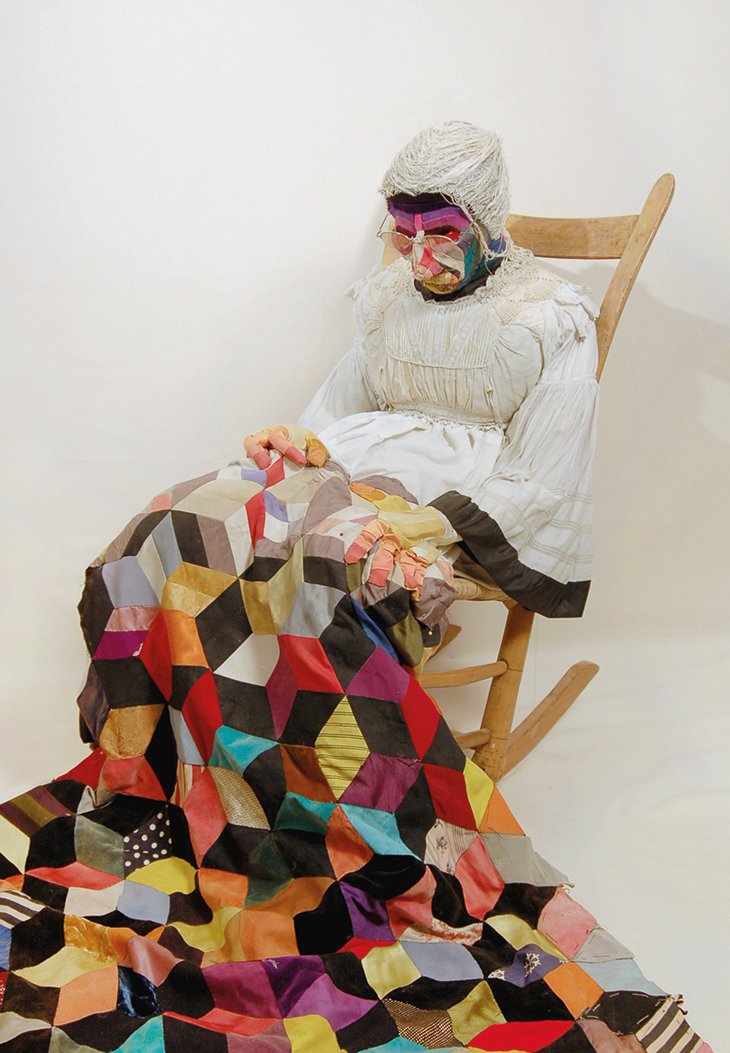This month, the city of Maastricht once again hosts the flagship fair of the European Fine Art Foundation (TEFAF) – still the continent’s pre-eminent marketplace for art and antiques. From 7–15 March, 280 dealers will convene at the Maastricht Exhibition & Conference Centre (MECC); they bring with them works of art spanning some seven millennia, many of which have not surfaced on the market for decades. Twenty-five newcomers enter the fray, six of them in the now 98-strong Antiques section, the remainder divided among Ancient Art, Design, Haute Joaillerie, Modern, Paintings, Paper, and Tribal. Once more, courtesy of the fair’s Showcase scheme, five recently established galleries dip their toes in the TEFAF water. Below, and in two further instalments this week, Susan Moore selects her highlights of the fair.
Old Lady II (1967), Jann Haworth
The Mayor Gallery, €120,000
Fresh from the artist’s collection and a retrospective at Pallant House, Chichester, this much-exhibited work is the centrepiece of a display of women Pop artists. The American-born Haworth pioneered soft sculpture in the 1960s, creating life-sized installations inspired by her watching her father, a Hollywood production designer, at work. Her sewn bodies are a feminist riposte to the prevailing representation of women in Pop art.

Old Lady II (1967), Jann Haworth. The Mayor Gallery at TEFAF Maastricht, €120,000
Jesus Preaching on the Sea of Galilee (1631), Frans Francken the Younger
Caretto & Occhinegro, in the region of €600,000
For its TEFAF debut in the Showcase section, the Turin-based gallery offers an unpublished monumental painting by the most famous member of this dynasty of Flemish artists. Both signed and dated, it belongs to a series of ambitious large-format works seemingly designed to demonstrate the artist’s mastery as a painter of figures and still life. More than 60 carefully composed characters can be found on this shore, as can a group of exotic shells.
Jesus Preaching on the Sea of Galilee (1631), Frans Francken the Younger. Caretto & Occhinegro at TEFAF Maastricht, in the region of €600,000
Venus and Cupid with Mercury and Psyche (c. 1600) Bartholomeus Spranger
Weiss Gallery, €5m
Newly discovered in Italy, this allegorical painting was almost certainly commissioned by the Holy Roman Emperor Rudolf II, for his Kunstkammer at Prague Castle. As court painter, Spranger developed a distinctive virtuoso style and high-key palette combining his native Netherlandish tradition with lessons newly absorbed in Rome. He specialised in mythological subjects combining the sensual female nude with erudite themes, often in the form of complex allegories. Here the inspiration appears to come from Terence’s comedy Eunuchus: ‘without Ceres and Bacchus, Venus grows cold’ – in other words, love needs food and wine to thrive. So this curled and bejewelled Venus holds grapes and ears of wheat. It is a subject favoured by Northern Mannerists such as Goltzius and Hans von Aachen, but here Spranger adds a lithe Mercury in flight to Mount Olympus, with Cupid poised in mid air as he leaps into action. The painting may well be the ‘Ceres and Cupid’ listed in the Prague inventory of 1619.
Venus and Cupid with Mercury and Psyche (c. 1600), Bartholomeus Spranger. Weiss Gallery at TEFAF Maastricht, €5m
Sammelband (1525–28) Albrecht Dürer
Dr Jörn Günther Rare Books, €280,000
Dürer goes under the spotlight here with a display devoted to this most pioneering and entrepreneurial of printmakers. Centre stage are his so-called ‘three large books’; the first of them, Apocalypse, with its 16 monumental woodcuts full of life and movement, is believed to be the first book created and published by an artist. The rare Sammelband (‘anthology’) is a compilation of three influential and groundbreaking artists’ manuals written towards the end of the artist’s life. Included is a treatise introducing to Northern Europe the principles of linear perspective and mathematical proportion in drawing, painting and architecture learned on a visit to Bologna, and illustrating an assortment of mechanical aids and methods. Here a drawing machine is used to trace the convergence between a lute, an intersecting plane and an ideal viewpoint, in effect a means of viewing and measuring the three-dimensional world and creating the illusion of it on a two-dimensional surface. Underneath are letter-forms that he also learned in Italy.
Sammelband (1525–28), Albrecht Dürer. Dr Jörn Günther Rare Books at TEFAF Maastricht, €280,000
Beckford bowl (1811–12)
H. Blairman & Sons, £90,000
Of the Regency works of art exhibited here, four belonged to the prodigiously wealthy antiquarian and art collector William Beckford, author of the gothic novel Vathek and builder of the immense Gothic Revival Fonthill Abbey. Enamelled with scrolling dahlias, the bowl is the earliest known and perhaps finest example of a series of Asian porcelains that were mounted to designs conceived by Beckford and his agent Gregorio Franchi. Its historicist silver-gilt lining is engraved with the medieval heraldic devices of martlets (birds without feet) set around the family coat of arms.
Beckford bowl (1811–12). H. Blairman & Sons at TEFAF Maastricht, £90,000
The Alessandri table (c. 1600 and 1850s)
Burzio, price on application
A product of the Florentine Grand Ducal Workshops, this pietra dura and pietra tenera inlaid tabletop was probably made to a design by Bernardino Buontalenti (1531–1608) and is testimony to the range of brilliantly hued and strikingly figured ancient marbles and semi-precious hardstones from across the globe that were favoured for wall and table decoration. As was common in the 18th century, the tabletop was cut in half to make two consoles, but it was later reunited on an elaborate baroque-style base bearing the Alessandri coat of arms.
The Alessandri table (c. 1600 and 1850s). Burzio at TEFAF Maastricht, price on application
From the March 2020 issue of Apollo. Preview and subscribe here.

